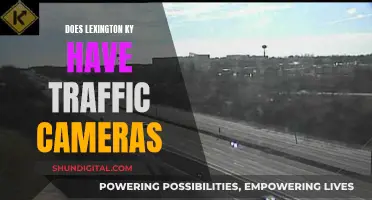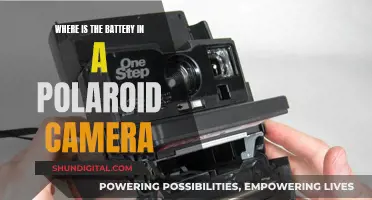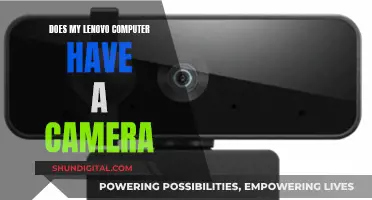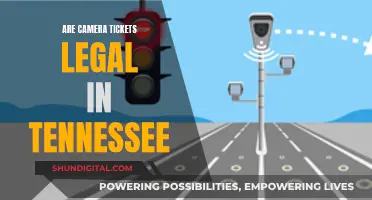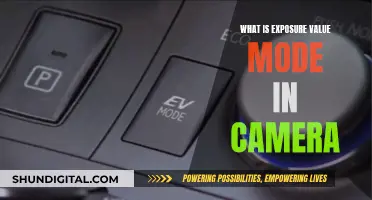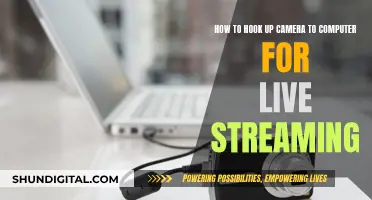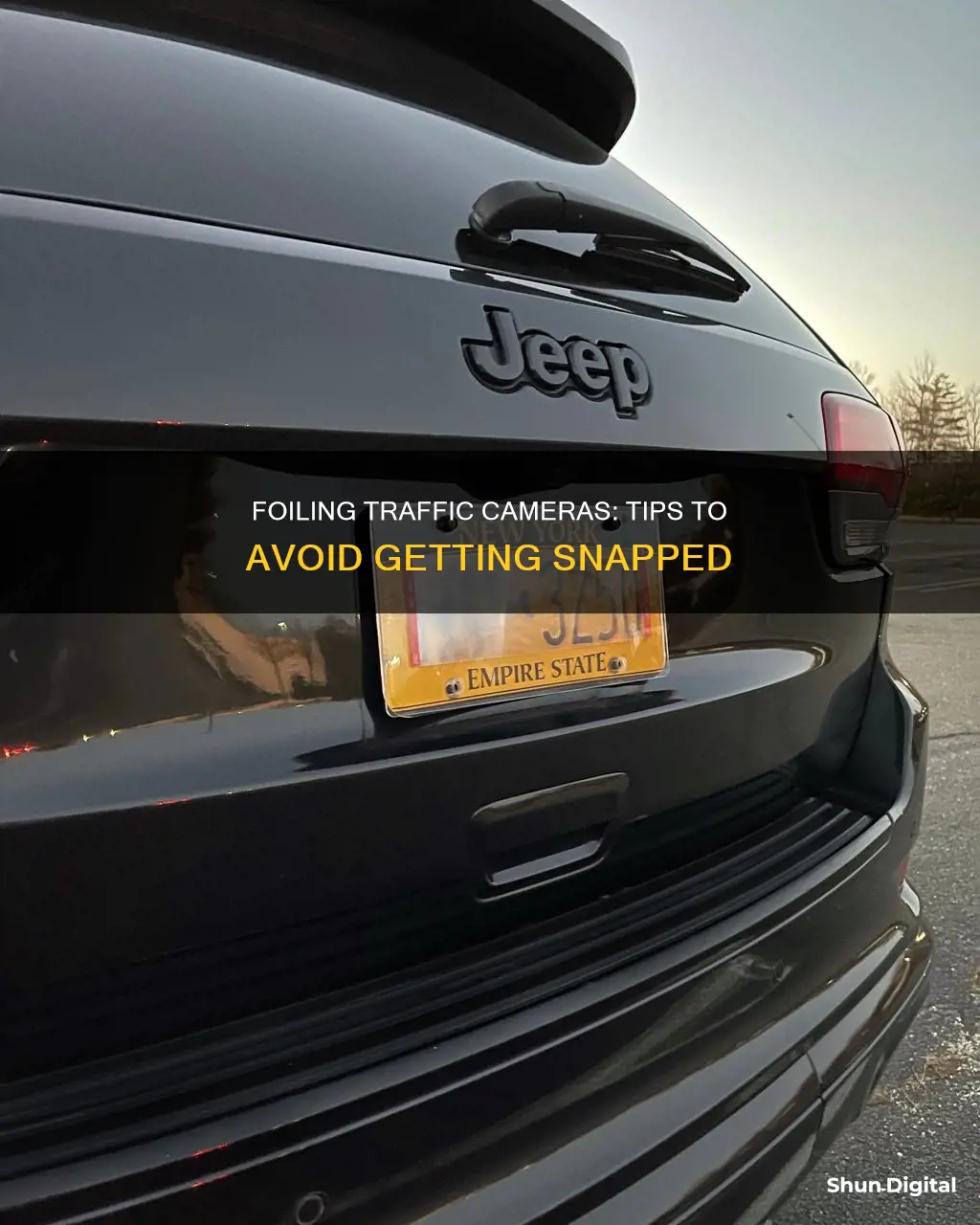
Traffic cameras are a contentious issue, with some people believing they are an infringement of privacy and a violation of citizens' rights. There are ways to avoid being caught by traffic cameras, such as the noPhoto invention by Jonathan Dandrow, which uses an optical flash trigger to detect the flash of a traffic camera and sets off xenon flashes to overexpose the photograph.
| Characteristics | Values |
|---|---|
| Product Name | noPhoto |
| Inventor | Jonathan Dandrow |
| Function | Detects the flash of a traffic camera and sets off xenon flashes to overexpose the license plate |
| Technology | Optical flash trigger |
| Detection Range | 150 feet in direct sunlight, farther in the dark |
| Filtering Circuit | Reduces false alerts by differentiating between natural light and camera flash |
| Power Adjustment | Increases power incrementally to ensure pictures are washed out |
| Legality | Legal as it doesn't obscure the license plate |
| Price | $350 |
What You'll Learn

Use a high-tech license plate frame to overexpose the photo
Traffic cameras can be a serious infringement of a driver's rights. If you're sick of receiving tickets, there is a way to throw a wrench into the money-making machine. Jonathan Dandrow has developed a high-tech license plate frame called "noPhoto" that makes it impossible for a red light or speed trap camera to snap a usable photograph of your plate.
The noPhoto is a license plate frame with a built-in optically-triggered slave-mode flash unit. A sensor at the top of the frame detects when a camera flash is fired, and this triggers two xenon flashes built into the sides of the frame. The powerful flash creates a bright light that washes out the license plate in the photograph, making it unreadable. This process is known as overexposing the image, and it prevents the camera from capturing a clear picture of your license plate.
One of the most challenging aspects of creating the noPhoto was engineering the flash detection circuitry. The device needed to be able to detect a camera flash from a significant distance while also differentiating between natural light sources and camera flashes to avoid false triggers. Dandrow and his team overcame this challenge by developing a hardware filtering circuit that reduced false alerts by over 90%.
The noPhoto is legal to use because it does not obscure the license plate. It simply exploits a weakness in the camera by overexposing the image, rendering the photograph useless for identifying the license plate number. This technology can be a powerful tool for those concerned about privacy and the potential errors and infringements associated with traffic enforcement cameras.
Newburgh Heights Camera Tickets: Are They Worth Paying?
You may want to see also

Employ optical flash triggers to detect the camera flash
Employing optical flash triggers to detect the flash of a traffic camera is a key component of the noPhoto invention by Jonathan Dandrow. This invention is a high-tech license plate frame that prevents traffic enforcement cameras from capturing a usable photograph of your license plate.
The optical flash trigger is a crucial part of this invention, as it detects the flash of the traffic camera and, in response, sets off xenon flashes from the sides of the license plate frame. This excess light causes the image of the license plate to be overexposed, making it unreadable.
The optical flash trigger used in noPhoto is unique in that it can detect a typical traffic enforcement flash from a significant distance, such as 150 feet or more in direct sunlight. This range nearly doubles in overcast or nighttime conditions.
One of the challenges in developing this technology was managing false triggers. Initially, the device was reacting to other light sources, such as the sun, car headlights, or even flashlights, which would set off the trigger. To address this issue, a hardware filtering circuit was created, reducing false alerts by over 90%.
The optical flash trigger plays a vital role in the functionality of the noPhoto invention, ensuring that the license plate image is overexposed and unreadable to the traffic camera.
How Police Car Cameras Work and Their Benefits
You may want to see also

Use xenon flashes to wash out the license plate
Jonathan Dandrow, the creator of noPhoto, believes that traffic enforcement cameras are “dangerous, invasive, error-prone, and unconstitutional.” In response, he created a high-tech license plate frame that makes it impossible for a red light or speed trap camera to capture a usable photograph of your license plate.
The noPhoto is essentially an optically-triggered slave-mode flash unit that is placed right next to the license plate. It features a sensor at the top of the frame that detects when a flash is fired, which then instantly triggers two powerful xenon flashes built into the sides of the frame. This intense burst of light overexposes the image, causing the license plate to appear as a rectangle of blown-out highlights, effectively washing out the details of the plate.
The engineering behind the noPhoto's flash detection circuitry was particularly challenging. While optical slave flash triggers have been available for years, they are typically ineffective outdoors due to infrared interference. To overcome this issue, Dandrow and his team developed a proprietary flash detection circuit that can detect a typical traffic enforcement flash from over 150 feet away in direct sunlight. It can even detect less powerful consumer camera flashes up to 60 feet away in the same conditions.
To address the issue of false triggers caused by other light sources such as sunlight, car headlights, or flashlights, the noPhoto incorporates a hardware filtering circuit. This filtering circuit can differentiate between various light sources, reducing false alerts by over 90%. This ensures that the noPhoto only activates when triggered by a traffic enforcement camera flash, maximizing its effectiveness and reliability.
The Evolution of Cameras: A Historical Perspective
You may want to see also

Apply a hardware filtering circuit to reduce false alerts
Radar detectors are an excellent tool to help you avoid speeding tickets, but they are not perfect. One of the main issues with radar detectors is the number of false alerts, which can be caused by various factors such as automatic door openers, in-vehicle safety systems, traffic flow sensors, and construction vehicles. These false alerts can be frustrating and reduce the effectiveness of the radar detector.
To address this issue, you can apply a hardware filtering circuit, specifically a Constant False-Alarm Rate (CFAR) scheme, to reduce false alerts. The principle behind CFAR is to vary the detection threshold based on the sensed environment. The circuit works by estimating the level of interference (noise or clutter) in radar range cells on either side of the cell under test and using this estimate to determine if there is a target in the cell of interest. This is based on the assumption that the noise or interference is spatially or temporarily homogeneous.
One specific implementation of CFAR is the Cell-Averaging Constant False Alarm Rate (CA-CFAR). In this method, the averaging of the amplitude values from the reference windows is carried out in the "arithmetic logic unit". The CA-CFAR graph shows strong values on either side of the target but relatively low values at the target itself, creating a contrast enhancement effect. By excluding the cells closest to the cell under test, the accuracy of the circuit can be improved, and the possibility of adjacent targets covering each other is reduced.
Another variation of CFAR is the Cell-Averaging Greatest Of-CFAR (CAGO-CFAR), which estimates the average power of clutter by analyzing each side of the sliding window separately and then selecting the maximum value. This method offers improved handling of non-homogeneous clutter environments and requires less computing power. However, it still faces challenges when dealing with adjacent targets and abrupt changes in disturbance signals.
By utilizing these hardware filtering circuits, you can enhance the performance of your radar detector, minimize false alerts, and ensure that you receive timely and accurate alerts for potential speeding violations.
Adjusting Your Camera for Manual Wedding Photography
You may want to see also

Differentiate between natural light and camera flash
The noPhoto license plate frame is a device designed to foil traffic cameras by making it impossible for them to capture a readable image of your license plate. The device uses a flash trigger to detect the flash of the traffic camera, which then sets off two xenon flashes on either side of the frame, overexposing the image and rendering the license plate unreadable.
One of the key challenges in developing this technology was differentiating between natural light and the flash of a traffic camera to avoid false triggers. Natural light can vary from harsh sunlight to diffused light through a window, but it will always be hard light and fairly cold due to the sky's cooling effect. In contrast, the flash of a camera is a bright burst of light that lasts only a fraction of a second.
To address the issue of false triggers, the noPhoto device employs a hardware filtering circuit that can differentiate between natural light and the light from a camera flash. This filtering circuit has been designed to reduce false alerts by over 90%.
While the concept of using a flash to counter a camera flash is not new, the noPhoto device's ability to differentiate between light sources and its long-distance detection range of up to 150 feet in direct sunlight set it apart. This technology not only has applications for defying law enforcement but also for privacy protection, such as for celebrities dealing with paparazzi.
Unleash Camera Raw's Power: Discovering MIROE
You may want to see also
Frequently asked questions
noPhoto is a high-tech license plate frame that makes it impossible for a red light or speed trap camera to snap a usable photograph of your license plate.
noPhoto has an optical flash trigger that detects the flash of a traffic-light camera. This sets off xenon flashes in the sides of the frame, so when the camera opens its shutter, there's too much light and the picture of your license plate is overexposed.
Yes, noPhoto is legal because it does not obscure the license plate.
noPhoto is expected to cost around $350, which is about the cost of a red-light ticket in many cities.
noPhoto was in the process of being crowdfunded on Indiegogo, with plans to mass-produce the item once it had been tested and certified.


